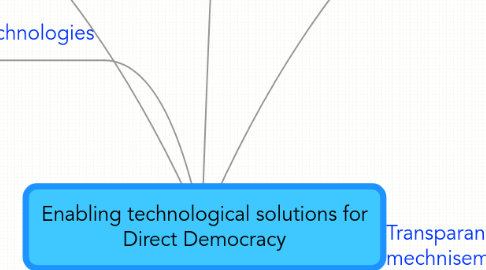
1. bi-directional communication: query the citizen occasionally with questions/info
2. Enabling technologies
2.1. b.
2.1.1. Text clustering & aggregation
2.1.1.1. group messages together based on semantic similarity
2.1.2. Causal relations
2.1.2.1. map causal relations between effects described in messages
2.1.2.2. automatically
2.1.2.2.1. using machine learning, semantic technologies & emergence mechanisms combining them
2.1.2.3. manually
2.1.2.3.1. e.g.
2.1.3. Rating & filtering
2.1.3.1. Enable thumb up/down voting on messages
2.1.3.2. Make messages visibility correspond to their rating
2.1.4. Self-organizing maps
2.1.4.1. present discussions in a spatial maps, in which the messages automatically position themselves, based on their semantics or context
2.1.5. Personal assistents/representatives
2.1.5.1. represent the citizen in discussions with other citizens
2.1.5.1.1. 1 person can't have a conversation with thousands of others, his virtual representative can
2.1.6. Semantic/context aware routing
2.1.6.1. maintain concept/tag cloud for citizens, that also includes the known attributes in their profile, & use it to route relevant messages to them
2.1.6.1.1. e.g.
2.1.7. Limit message size in discussions to X characters
2.1.7.1. with the option of links to further content
2.1.8. Add dimensions to messages, that enable intelligent focus/attention management
2.1.8.1. e.g.
2.1.8.1.1. Importance/urgency/value
2.1.8.1.2. Effort/complexity/cost
2.1.8.2. Dimensions will be collaboratively edited
2.1.8.3. Focus charts can be used to direct attention to the discussions/messages that most require/deserve focus
2.1.8.3.1. Appear in the magic quadrant of the focus chart
2.1.9. Slicing by tags & dimensions
2.1.9.1. Enable view filtering by tags (explicit or implicit) & message dimenions
2.1.10. Quick entry mode for easy\rvoice of the people area
2.1.10.1. Supporting also anomimous mode, for reporting corruptness &c
2.1.10.2. Where people can very easily report problems or request changes
2.2. c.
2.2.1. Show discussions as a logical flow toward an agreed goal
2.2.1.1. stages in the flow are aggregated opinions/explanations/alternative solutions
2.2.1.2. transitions between stages are based on logical causation
2.2.1.3. resulting graph looks like an octoput in which
2.2.1.3.1. the head is the agreed goal
2.2.1.3.2. every leg is an alternative for achieving the agreed goal
2.2.1.4. enable voting and discussions around stages
2.2.1.5. enable comparison between stages
2.2.1.6. enable voting and discussion around the transitions
2.2.1.6.1. in effort to break assumptions
2.2.2. Simulate suggested solutions to enable better understanding of their implications & results
2.2.2.1. Using
2.2.2.1.1. Just textual collaborative discussion of an imagined solution
2.2.2.1.2. Implementation of the solution in a virtual world (e.g., Second Life)
2.2.2.1.3. Multi-agents system simulation
2.2.3. Implement decision support tools
2.2.3.1. e.g.
2.2.3.1.1. WikiDebate
2.2.3.1.2. Delphi method
2.2.3.1.3. IPA
2.2.3.1.4. Dotmocracy
2.2.4. Embed secured online voting systems for the final decision
2.2.4.1. e.g.
2.2.4.1.1. Open-Audit voting systems, such as Helios
3. b. Large-scale multi-participant discussion
3.1. place in which thousands of citizens will be able to discuss
3.2. while avoiding clutter
3.2.1. everyone can easily find something that will enrich him
3.2.2. & possibly also contribute himself
3.2.3. incurage informative and nice talks
3.2.4. discussing in logic tree
3.2.5. diffrnaitae between facts, views, theories, values, conclstions etc
3.2.6. scale with number of diff views not on number of particpents
3.2.7. become more mature and reach over time
3.2.8. easly relate to other discctions and "info pages"
4. Enable 3 Direct Democracy mechanisms
4.1. a. Government/ Parlament/court/local gov transparency
4.1.1. What does the government do
4.1.1.1. budgets
4.1.1.2. what are gov officals doing right now- "twiter"
4.1.1.3. what are the palns for coming futrue
4.1.2. What information does it have
4.1.2.1. New node
4.2. c. Decision making mechanism
4.2.1. a place in which a group can make decisions based on
4.2.1.1. advice
4.2.1.2. public discussion
4.2.1.3. scientific debate
4.2.2. if possible, by concensus
4.2.2.1. while avoing negative "group thinking"
4.2.3. if not, by majority
4.2.4. enjoing
4.2.4.1. info and knoladge of msny brains and viewpoints
4.2.5. avoidng
4.2.5.1. laowest delimter
4.2.5.2. popolisem
4.2.5.3. elite enforcment positive loop
4.2.6. dilamas
4.2.6.1. one man - one voice VS no power without responcebiltes (benfit to knoladge)
5. Transparancy mechnisems
5.1. What does the government do
5.1.1. taxes
5.1.2. tax reductions
5.1.3. budgets
5.1.4. what are gov officals doing right now- "twiter"
5.1.5. what are the palns for coming futrue
5.1.6. laws and regulations
5.1.7. open code
5.1.8. conserns for conflict intrests
5.1.9. michrazim, buy equipments
5.2. What information does it have
5.2.1. statistics on citizens, firms, fenomams (CBS)
5.2.1.1. Tools
5.2.1.1.1. Google Visulazing
5.2.2. distrebution of common resourcesa common infastructure (air, bech, land, water, roads , schools, hospitals etc)
5.2.3. commns iamges, texts
5.3. in monicipalites
5.3.1. construction plans
5.3.2. city palning
